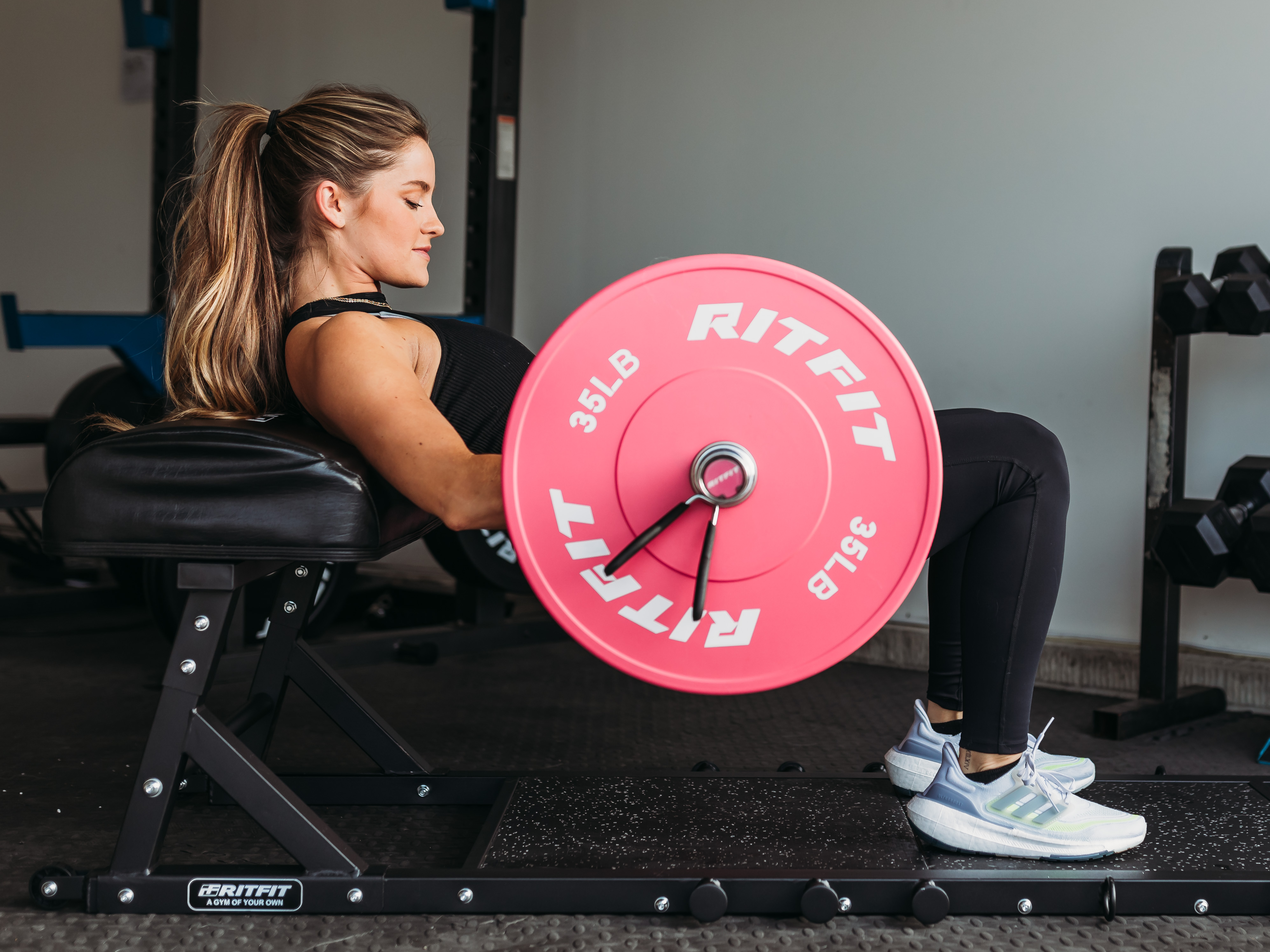
1 BULGARIAN SPLIT SQUAT TO BICEP CURL
This exercise combo is all about the booty and arms (aka glutes and biceps). HOW TO DO IT: Place one foot on a stable bench or platform behind you. Step the opposite leg far out in front of you so that when you squat down you create a 90-degree angle with your front knee. Hold a dumbbell in each hand and keep your core tight as you squat. Squeeze the glutes and drive up, performing a bicep curl at the top of the split squat. Switch legs and repeat.

2 STEP-UP TO OVERHEAD PRESS
The first part of this exercise targets the lower body, while the second part strengthens your upper body -- and the entire exercise challenges your core. HOW TO DO IT: Using a stable step or bench, start with one foot on the bench so that your knee is at a 90-degree angle. With a dumbbell in each hand in the front-rack position, step up onto the bench. At the top of the step-up, press the dumbbells overhead. Lower back down and repeat on the opposite leg.

3 BENCH PRESS TO LEG RAISE
Skip the bench of the traditional bench press and perform this exercise on the floor. HOW TO DO IT: Lie on the floor with dumbbells or barbell in hand. Start with the dumbbells/barbell a few inches off your chest, then press up to the sky. As the weight is at the top, raise your legs up till your legs and arms are parallel to each other (and perpendicular to the floor).

4 PULL-UP TO TOES-TO-BAR
Regular pull-up not challenging enough for you? Try this amped-up variation for maximal lower-ab engagement. HOW TO DO IT: Start by hanging from a pull-up bar. Complete a strict pull-up by engaging the core and squeezing the lats together. With control, lower back down to the starting position. Then, with your legs as straight as possible, contract your abs and raise your toes so that they tap the pull-up bar. Lower down and repeat.

5 WALKOUT PLANK TO PUSH-UP
Also known as an inchworm push-up, this variation on the standard plank-to-push-up combo hits every major muscle group. HOW TO DO IT: Start with your feet hip-width apart. Bend at the waist and place your hands on the floor. While keeping a stable core, walk your hands out to a plank position. While in the plank position, lower down to a push-up and raise back up. Walk your feet to your hands and repeat. If you don’t have that much space, you can also walk your hands back to your feet after each rep.

6 SHOULDER TAP TO PUSH-UP
With this exercise, you’ll really need to focus on keeping your entire core stable and not rolling to one side or the other as you tap each shoulder. HOW TO DO IT: Start in the plank position with your hands on the floor and shoulders over your wrists. Spread your feet apart several inches to gain better balance. While keeping your core stable, raise the right hand to tap the left shoulder and lower your hand back down. Then tap the left hand to the right shoulder and lower it back down. After you have tapped both shoulders, drop down into a push-up, getting your chest as close to the floor as possible while keeping your back straight, then press back up to the starting position.
7 PUSH-UP TO ROW
Also known as the renegade row, this move is an upper-body toner. HOW TO DO IT: Start in the push-up position with a dumbbell in each hand. Spread your feet apart to gain more control and balance over your body. Lower down into the bottom of a push-up and raise back up to the starting position. At the top of your push-up, row the right arm back so that your hand is close to your armpit while keeping it close to your side. Your elbow should be pointed straight up to the ceiling. Lower down and repeat on the other side. With each push-up, change the arm you’re rowing with.

8 DUMBBELL SQUAT TO OVERHEAD PRESS
Squats are one of the best exercises you can do to build functional strength, but sometimes you need a break from the traditional squat. Mix it up with this variation. HOW TO DO IT: Start with dumbbells in a front-rack position and your feet a little wider than hip-width apart. Squat down (below parallel if your mobility allows) and drive back up. As you drive up, use your momentum to launch the dumbbells overhead. You can also pause between the squat and the overhead press if the momentum is too stressful on your joints.

9 HANG POWER CLEAN TO FRONT SQUAT
These last two moves require a bit of weightlifting skill and practice, so perfect your form first before adding weight. HOW TO DO IT: Start in the hang position with the barbell in front of you (unloaded if you’re a beginner). Your starting position is similar to that of a deadlift, but with both palms facing your body. Hold the bar just above your knees and feel your hamstrings engage. Then drive the hips (as though you were jumping) and shrug so that the bar goes straight up the front of your body. Since this is a power clean, you should drop to a quarter-squat position to receive the bar, whipping the elbows in front of you to start your front squat. With the bar resting across your collarbone, lower down into a front squat. As you drive up, think of screwing your feet outward into the ground to fully engage your glutes.

10 HANG POWER SNATCH TO OVERHEAD SQUAT
Instead of performing a full-squat snatch, you can break the movements apart to gain greater control. This is a great option for beginners because it gives you time to master the proper form. HOW TO DO IT: Start from the hang position with your arms wider than your shoulders (in snatch position). If you were to stand up, the bar would hit your hip crease. Bend at the hips so that you engage your hamstrings. Extend the hips and pull the bar as high as possible to receive the bar overhead. Drop into a quarter squat to receive the weight of the bar. Once the bar is overhead you may need to adjust your foot placement so that your mobility allows you to squat down with the bar above you. Next, tighten your core and lower down into an overhead squat. Stand back up and drop the bar with control so that you are back to the starting position.








